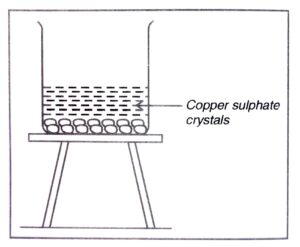SEBA Class 7 Science Chapter 6 Physical and Chemical Changes – Textbook Solutions & MCQ (Part I)
Get Class 7 Science Chapter 6 “Physical and Chemical Changes” Solutions for SEBA Assam (English Medium) students. This chapter, from Part I of the Science book, explains the differences between physical and chemical changes, characteristics of chemical reactions, rusting of iron, crystallization, and the importance of changes in daily life. Our solutions provide detailed NCERT/SCERT textbook answers, important MCQs, and key explanations to help students understand the fundamental concepts of physical and chemical transformations. These solutions are structured to make learning easy and effective for exam preparation.
Class 7 Science
Chapter – 6 (Part I) Ospin Academy
Physical and Chemical Exercises
EXERCISE
Q. 1. Classify the changes involved in the following processes as physical or chemical changes.
(a) Photosynthesis
(b) Dissolving sugar in water
(c) Burning of coal
(d) Melting of wax
(e) Beating aluminum to make aluminum foil
(f) Digestion of food.
Ans: Physical Change: (b), (d), (e)
Chemical Change: (a), (c), (f)
Q.2. State whether the following statements are true or false. In case a statement is false, write the corrected statement in your notebook.
(a) Cutting a log of wood into pieces is a chemical change.
Ans: False.
(b) Formation of manure from leaves is a physical change.
Ans: False.
(c) Iron pipes coated with zinc do not get rusted easily.
Ans: True.
(d) Iron and rust are the same substances.
Ans: True.
(e) Condensation of steam is not a chemical change.
Ans: True.
Q. 3. Fill in the blanks in the following statements:
(a) When carbon dioxide is passed through lime water, it turns milky due to the formation of _________.
Ans: Calcium carbonate.
(b) The chemical name of baking soda is _________.
Ans: Sodium hydrogen carbonate.
(c) Two methods by which rusting of iron can be prevented are _________ and _________.
Ans: Coating, galvanization.
(d) Changes in which only _________ properties of a substance change are called physical changes.
Ans: Physical.
(e) Changes in which new substances are
formed are called _________ changes.
Ans: Chemical.
Q. 4. When baking soda is mixed with lemon juice, bubbles are formed with the. evolution of a gas. What type of change is it? Explain.
Ans: The reaction between baking soda and lemon juice can be given as below:
Lemon juice + Baking soda →
(Citric acid) (Sodium hydrogen carbonate)
CO2, (bubbles) + Other
Carbon dioxide Substances
It is a chemical change.
Q.5. When a candle burns both physical and chemical changes take place. Identify these changes. Give another example of a familiar process in which both the chemical and physical changes take place.
Ans: Physical change: Melting of wax. Chemical change :Burning of candle.
LPG is another example in which physical change occurs. When LPG comes out of cylinder and is converted from liquid to gaseous state and a chemical change occurs when gas burns in air.
Q. 6. How would you show that setting of curd is a chemical change?
Ans: The conversion of milk into curd, i.e., setting of curd is a permanent as well as irreversible and lead to the production of a new substance. The new substance, curd is formed has different composition and properties from the milk. Hence, setting of curd is a chemical change.
Q. 7. Explain why burning of wood and cutting it into small pieces are considered as two different types of changes.
Ans: Burning of wood is a chemical change because, in addition to new products burning is always accompanied by production of heat.
Cutting of wood into small pieces is a physical change because, pieces of wood underwent changes in size and no new substance is formed.
Q. 8. Describe how crystals of copper sulfate are prepared?
Ans: Preparation of crystals of copper sulfate: Take about 100 mL of water in a beaker and add a few drops of dilute sulphuric acid to it. Heat the water over a burner till it boils. Add copper sulphate slowly to the hot water with constant stirring. Continue to add copper sulphate till no more copper sulphate can

Fig. 6.8. Making crystals of copper sulfate.
be dissolved. This will give us saturated solution of copper sulphate. Filter the hot saturated solution of copper sulphate to remove insoluble impurities. Allow the hot and concentrated solution of copper sulfate to cool slowly. Do not disturb the solution when it is cooling. After some time we will see large copper sulfate crystals at the bottom of the beaker.
Separate the copper sulphate crystals from solution by filtration and dry. The soluble impurities present in copper sulphate do not crystallise and hence remain behind in the solution.
Q. 9. Explain how painting of an iron gate prevents it from rusting.
Ans: The process of rusting can be represented by the following equation:
Iron (Fe) + Oxygen (O2, from the air) + Water (H2O)→ Rust (iron oxide, Fe2O3) (H₂O)
For rusting the presence of both oxygen and water (or water vapour) is essential.
In fact, if the content of moisture in air is high, which means if it is more humid, rusting becomes faster. So, to prevent iron gate from coming in contact with oxygen, or water, or both one simple way is to apply a coat of paint or grease. In fact, these coats should be applied regularly to prevent rusting.
Q. 10. Explain why rusting of iron objects is faster in coastal areas than in deserts.
Ans: The water of coastal areas contain many salts. The salt water makes the process of rust formation faster. Thus, rusting of iron objects is faster in coastal areas than deserts.
Q. 11. The gas we use in the kitchen is called liquefied petroleum gas (LPG). In the cylinder it exists as a liquid. When it comes out from the cylinder it becomes a gas (Change-A), then it burns (Change-B). The following statements pertain to these changes. Choose the correct one.
(i) Process ― A is a chemical change.
(ii) Process ― B is a chemical change.
(ii) Both processes A and B are chemical changes.
(iv) None of these processes is a chemical change.
Ans: (iii) Both process A and B are chemical changes.
Q. 12. Anaerobic bacteria digest animal waste and produce biogas (Change – A). The biogas is then burnt as fuel (Change B). The following statements pertain to these changes. Choose the correct one.
(i) Process ― A is a chemical change.
(ii) Process ― B is a chemical change.
(ii) Both process A and B are chemical changes.
(iv) None of these processes is a chemical change.
Ans: (iii) Both process A and B are chemical changes.
FAQs – Class 7 Science Chapter 6 (Physical and Chemical Changes, SEBA Assam)
Q1: What is the difference between physical and chemical changes?
Physical changes affect only the appearance of a substance without forming a new one, while chemical changes create new substances with different properties.
Q2: What are examples of physical changes?
Examples include melting of ice, breaking of glass, dissolving salt in water, and boiling water.
Q3: What are examples of chemical changes?
Examples include rusting of iron, burning of wood, digestion of food, and formation of curd from milk.
Q4: Where can I find Class 7 Science Chapter 6 solutions for SEBA Assam?
You can find detailed textbook solutions, MCQs, and explanations for SEBA Assam Class 7 Science Chapter 6 on this page.
Q5: Where can I find solutions for all Class 7 Science chapters?
To get solutions for all Class 7 Science chapters, Click Here

